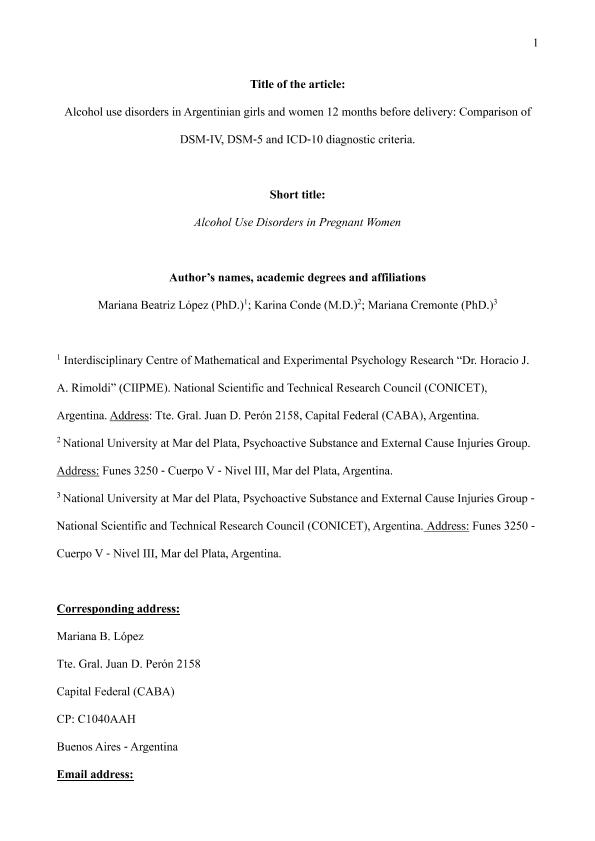Artículo
Alcohol use disorders in argentinian girls and women 12 months before delivery: Comparison of DSM-IV, DSM-5, and ICD-10 diagnostic criteria
Fecha de publicación:
03/2017
Editorial:
Lippincott Williams
Revista:
Journal Of Addiction Medicine
ISSN:
1932-0620
Idioma:
Inglés
Tipo de recurso:
Artículo publicado
Clasificación temática:
Resumen
Background: The evidence of important problems related to prenatal alcohol exposure has faced researchers with the problem of understanding and screening alcohol use in this population. Although any alcohol use should be considered risky during pregnancy, identifying alcohol-drinking problems (ADPs) could be especially important because women with ADPs could not benefit from a simple advice of abstinence and because their offsprings are subjected to a higher risk of problems related with prenatal alcohol exposure. In this context, we aim to study the prevalence and characteristics of ADPs in pregnant women, evaluating the performance of different diagnostic systems in this population. Objectives: The aims of the study were to describe the prevalence of ADPs obtained with the criteria of the Diagnostic and Statistical Manual of Mental Disorders in its fourth (DSM-IV) and fifth edition (DSM-5), and the International Classification of Diseases (ICD)-10, in Argentinean females aged 13 to 44 years, 12 months before delivery; to evaluate the level of agreement between these classification systems; and to analyze the performance of each diagnosis criterion in this population. Methods: Data were collected through personal interviews of a probability sample of puerperal women (N=641) in the city of Santa Fe (Argentina), between October 2010 and February 2011. Diagnoses compatible with DSM-IV, DSM-5, and ICD-10 were obtained through the Composite International Diagnostic Interview. Agreement among diagnostic systems was measured through Cohen kappa. Diagnosis criteria performance were analyzed considering their prevalence and discriminating ability (D value). Results: Total ADP prevalence was 6.4% for DSM-IV (4.2% abuse and 2.2% dependence), 8.1% for DSM-5 (6.4% mild, 0.8% moderate, and 0.9% severe alcohol use disorder), and 14.1% for the ICD-10 (11.9% harmful use and 2.2% dependence). DSM-5 modifications improved agreement between DSM and ICD. The least prevalent and worst discriminating ability diagnostic criterion was "legal problems." The most prevalent and 1 of the best discriminating ability diagnostic criterion was '"health issues." Conclusions: DSM-IV and ICD-10 dependence prevalence was similar to that of previous studies in pregnant women, whereas abuse prevalence was surprisingly higher. Our results indicate a better performance of the DSM-5 alcohol use disorder category relative to the DSM-IV dual categorization. Nevertheless, the poor diagnostic performance of some DSM-5 criteria in this population could evidence their intercultural variability.
Palabras clave:
Alcohol Use Disorders
,
Dsm-5
,
Dsm-Iv
,
Icd-10
,
Pregnant Women
Archivos asociados
Licencia
Identificadores
Colecciones
Articulos(CCT - MAR DEL PLATA)
Articulos de CTRO.CIENTIFICO TECNOL.CONICET - MAR DEL PLATA
Articulos de CTRO.CIENTIFICO TECNOL.CONICET - MAR DEL PLATA
Citación
López, Mariana Beatríz; Conde, Karina Natalia; Cremonte, Mariana; Alcohol use disorders in argentinian girls and women 12 months before delivery: Comparison of DSM-IV, DSM-5, and ICD-10 diagnostic criteria; Lippincott Williams; Journal Of Addiction Medicine; 11; 2; 3-2017; 106-113
Compartir
Altmétricas




